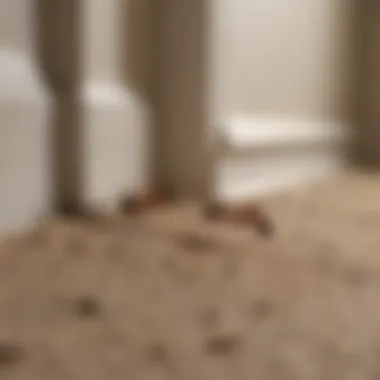Effective Strategies to Keep Ants Out of Your Home


Intro
Keeping ants out of your house is a common concern for many homeowners. Understanding the behavior of these pests is crucial for effective prevention. Ants are social insects that communicate and work collectively. Once they find a food source, they leave a pheromone trail for others to follow. This ability can quickly lead to a large infestation if not addressed promptly. In this article, we will explore effective strategies to mitigate and prevent ant incursions, providing practical solutions for maintaining a pest-free environment.
Pest Identification
Detailed descriptions of common pests
Several species of ants may invade residential homes, with the most prevalent being the carpenter ant, odorous house ant, and ghost ant. Carpenter ants are large and may cause structural damage to wooden components of your home. They are typically black or bicolored, and you might notice them around damp, decaying wood. Odorous house ants are small and emit a distinct smell when crushed, resembling rotten coconut. Ghost ants are very small with pale bodies and dark legs, which can sometimes go unnoticed until there’s a considerable presence.
Signs and symptoms of infestations
Identifying an ant problem early is vital. Look for:
- Live ants scuttling across counter tops or floors.
- Pheromone trails on surfaces directing other ants.
- Ant colonies can be found outdoors in soil or under debris.
- Materials like wood shavings or piles of dirt around windows and doors can indicate carpenter ants.
Prevention Strategies
Home maintenance tips for pest prevention
To prevent ants from entering, homeowners should conduct regular house maintenance. Simple steps can greatly deter ants, including:
- Sealing cracks and crevices around windows, doors, and foundations.
- Ensuring that screens on windows and doors are intact, free from holes or tears.
- Storing food in airtight containers and cleaning crumbs and spills promptly.
Natural deterrents and barriers
Alongside these measures, several natural deterrents can be effective. Common household items can be used:
- Vinegar and water solution: Spray this solution around entry points.
- Citrus peels: Ants tend to avoid citrus scents, so placing peels near entrances can help.
- Essential oils: Oils like peppermint and tea tree can repel ants when applied to vulnerable areas.
Treatment Options
Overview of chemical vs. natural treatments
When the infestation is significant, distinguishing between chemical and natural treatments is essential. Chemical insecticides can quickly kill ants but may pose health risks for people and pets. Natural options are generally safer, though they may take longer to prove efficient.
Step-by-step guides for DIY treatments
To utilize natural methods effectively, follow these steps for a vinegar ant spray:
- Mix equal parts of vinegar and water in a spray bottle.
- Identify and spray directly onto ants and entrances they use.
- Wipe the area clean after a few minutes to eliminate pheromone trails.
Effective prevention and treatment require ongoing vigilance and adaptation to the specific conditions of your household. By understanding ant behavior and implementing these strategies, you can reduce the likelihood of future infestations.
Understanding Ant Behavior
Understanding ant behavior is crucial for homeowners seeking to prevent these pests from entering their living spaces. Ants are social insects known for their structured colonies and complex social systems. They communicate and cooperate in ways that can help them thrive, often making them a formidable presence once they infiltrate a home. By learning about their habits, tendencies, and preferences, individuals can formulate effective strategies to keep them out.
Ant Species Commonly Found in Homes
There are several ant species that frequently invade homes. Some of the most common include:
- Carpenter Ants: These ants are known for hollowing out wood to create nests, causing structural damage to homes.
- Odorous House Ants: Named for their distinct smell, these ants are attracted to sugary substances and often form large colonies.
- Pavement Ants: These ants typically build their nests under pavements, but will also invade houses in search of food.
- Sugar Ants: These are small and black. They are commonly found in kitchens scouring for sweets.
Each ant species has specific behaviors and preferences that inform how to best protect your home from them. In understanding which species may be present, targeted prevention methods can be employed more effectively.
Ant Foraging Patterns


Ant foraging patterns greatly impact how they invade human dwellings. Ants usually send out scouts to locate food sources. Upon discovering food, they leave a pheromone trail back to the colony. Other ants then follow this trail, increasing the likelihood of an infestation.
To disrupt this pattern:
- Keep food stored in sealed containers.
- Clean up spills and crumbs promptly.
- Make sure pet food is not left out, especially overnight.
By recognizing these foraging behaviors, homeowners can implement preventative measures that can significantly reduce the chances of an ant invasion.
Nesting Habits of Ants
Ants build nests in a variety of locations. They prefer warm, moist environments, which often include places within a home. Common nesting areas include:
- Inside walls
- Under floorboards
- In basements or attics
Some species may establish nests in outdoor locations near the home, such as gardens or beneath rocks. Knowing the nesting habits of different ant species can inform where to inspect for potential ant colonies.
Regular inspections of potential nesting sites can help in early detection, making it easier to address problems before they escalate.
By understanding these fundamental aspects of ant behavior, homeowners can take proactive steps in safeguarding their homes from these invaders.
Identifying Ant Entry Points
Understanding how ants gain access to your home is crucial in preventing infestations. Identifying these entry points is the first step toward effective ant control. Knowing where ants typically enter allows homeowners to take proactive measures in sealing off those areas. This knowledge not only prevents future infestations but also helps minimize the risk of other pests entering your living space.
Common Access Locations
Ants are small and can exploit various gaps and cracks around your home. Here are common places to look for entry points:
- Cracks in Foundation: Inspect the foundation for cracks, as these are easy entry points.
- Around Windows and Doors: Check the weather stripping and seals; damaged seals can allow ants to enter.
- Vents and Utility Openings: Ensure that all vents have proper screens. Utility access points for cables or pipes should be sealed properly.
- Electrical Outlets: Sometimes, ants can enter through small openings around outlets and switches, particularly on exterior walls.
- Through Soil and Mulch: Ant colonies often build their nests in soil close to the house. If soil or mulch is piled against the foundation, it may provide easy access.
By regularly inspecting these areas, you can maintain a barrier against potential ant invasions.
Signs of Ant Infestation
Identifying the signs of an ant infestation early can significantly aid in controlling their presence. Look for the following indicators:
- Visible Ant Trails: Discerning a line of ants is often the most obvious sign of an infestation.
- Nesting Activities: If you find small piles of dirt or sawdust, it may indicate a nest nearby.
- Food Sources: If you notice that food items, particularly sweets and proteins, seem to disappear, ants may be scavenging.
- Waste Piles: Dead ants or droplets of an oily substance often signify a larger colony nearby.
It is important to act swiftly when you observe these signs. The longer ants are allowed to thrive, the more challenging the eradication will become.
Preventive Measures to Keep Ants Out
Preventive measures are crucial in maintaining a home that is not welcoming to ants. These strategies not only involve immediate actions but also long-term tactics. Proper prevention can save time, effort, and money by reducing the likelihood of an infestation. Moreover, understanding how ants enter our homes enables homeowners to implement targeted solutions that protect their living environment.
In this section, we will delve into specific strategies such as sealing up potential entry points, installing physical barriers, and maintaining cleanliness. Each method has its own unique benefits and considerations, which will ensure a comprehensive defense against these persistent pests.
Sealing Cracks and Gaps
Ants can squeeze through surprisingly small openings. Sealing cracks and gaps in your home is one of the most effective and inexpensive ways to keep ants out.
- Identify Vulnerability: Begin by examining areas like windows, doors, and the foundation. Pay attention to tiny cracks that might go unnoticed. Use a flashlight to spot any openings.
- Choose Appropriate Materials: A variety of materials can be used for sealing. Caulk works well for small spaces. For larger gaps, expanding foam can provide a sturdy barrier. Be sure to use weatherstripping or door sweeps on external doors.
- Regular Maintenance: Sealing is not a one-time issue. Regularly inspect these areas, especially after harsh weather, which can introduce new openings.
By closing off these entry points, homeowners create a less accessible environment for ants, thus significantly reducing the chances of an infestation.
Utilizing Screens and Barriers
Installations of screens on windows and doors is an effective physical barrier against ants and other pests. Screens can serve multiple functions, providing ventilation while still keeping unwanted guests out.
- Choose Quality Screens: It's essential to select durable screens that can withstand wear and tear. Consider options that fit snugly over all openings.
- Physical Barriers: Beyond screens, consider using barriers like copper mesh or fine mesh fabric for known entry points. These materials can be placed inside the cracks and prevent ants from crawling through.
- Routine Checks: Regularly inspect screens for tears or holes. If any damages are found, replace them promptly to maintain effective protection.


These measures allow for airflow in the home while effectively creating a barrier against ants.
Maintaining Cleanliness Around the House
An often-overlooked strategy is sustaining a clean environment within and around the home. Ants are drawn to food sources and cluttered spaces, making cleanliness a vital defense measure.
- Immediate Clean-Up: Clean food spills and crumbs right away. This includes wiping down surfaces in the kitchen and dining areas.
- Proper Food Storage: Store food in airtight containers. This is especially important for sugary items that attract ants. Similarly, pet food should also be stored correctly.
- Regular Garbage Disposal: Regularly empty garbage cans and ensure they are sealed tightly. This helps to eliminate potential food sources.
Keeping a tidy home ensures there are fewer attractants for ants. When combined with other preventive measures, maintaining cleanliness plays a significant role in a robust ant prevention strategy.
Natural Repellents for Ant Control
Natural repellents offer an effective and safer approach to managing ant infestations. These methods often utilize ingredients available in most homes. Their use can reduce reliance on chemical solutions, which might pose risks to pets, children, and the environment. Understanding how these natural substances work can empower homeowners to reclaim their space effectively without harsh chemicals.
Essential Oils as Deterrents
Essential oils have gained popularity in pest control due to their strong scents and powerful properties. Many species of ants find these odors intolerable, making essential oils a viable option for deterrence.
Some effective oils include:
- Peppermint Oil: Its strong minty aroma is particularly offensive to ants.
- Tea Tree Oil: Known for its antimicrobial properties, it also disrupts ant pheromones, making it harder for them to communicate.
- Lavender Oil: The strong floral scent repels ants while providing a pleasant aroma to the home.
To use these oils, mix a few drops with water in a spray bottle and apply it around suspected entry points. Regular application can maintain its effectiveness.
Vinegar Solutions
Vinegar is a versatile household item that serves well as a natural repellent. Its acetic acid content disrupts the scent trails ants use to navigate, which is essential for their foraging behavior.
To create an effective ant-repelling solution, combine equal parts of vinegar and water in a spray bottle. Spray this mixture around doors, windows, and other potential entry points. The strong smell dissipates quickly but is sufficient to deter ants effectively. The solution can be reapplied daily or whenever ant activity is noticed.
Citrus Peels and Other Natural Remedies
Citrus peels, particularly from lemons and oranges, are an underutilized but effective natural ant repellent. Their citrus scent is unappealing to many insect species, including ants. Simply scatter the peels around areas without any concern about toxins, as they are completely safe.
Other simple remedies include:
- Cinnamon: Its strong scent works similarly to essential oils and can be sprinkled around entry points.
- Coffee Grounds: Used grounds can be scattered in areas where ants are active; the scent repels them without creating harm.
- Chalk: A line of chalk can demarcate boundaries; some ants do not cross it.
Using these natural repellents can promote a pest-free environment without the harshness of chemicals. Regular application and integrated household routines that keep areas clean contribute positively to their effectiveness.
Chemical Solutions for Ant Extermination
Understanding chemical solutions for ant extermination is crucial for effective pest management. While natural methods can deter ants, sometimes these strategies may not suffice, especially during severe infestations. Chemical solutions can offer a more immediate and targeted response to eliminate existing ant populations. However, it is essential to consider the potential health risks and environmental impact of these chemicals.
Benefits of Chemical Solutions
- Efficiency: Chemical treatments often provide quicker results compared to natural methods.
- Targeted Application: Specific products can be used to target particular ant species effectively.
- Long-lasting Effects: Many commercial products offer prolonged protection, reducing the likelihood of reinfestation.
- Ease of Use: Over-the-counter options allow homeowners to effectively manage infestations without needing professional assistance.
Considerations
It is important to read labels carefully and follow all instructions when using chemical products. Some solutions may require specific safety precautions to avoid harming non-target organisms, children, and pets. Furthermore, repeated use of the same chemicals can result in resistance, prompting a need for alternative strategies over time.
Over-the-Counter Ant Sprays
Over-the-counter ant sprays are popular among homeowners for their immediate effectiveness. These products are readily available at most stores and provide a quick solution to visible ant problems. Many sprays contain active ingredients such as pyrethroids or neonicotinoids, which target the nervous system of ants, leading to their quick demise.
When using these sprays, it is important to apply them directly to ant trails and nests. Here are some tips:
- Ensure proper ventilation while using chemical sprays indoors.
- Keep pets and children away from treated areas until they are dry.
- Consider the environment by opting for biodegradable options when possible.


Baits and Trap Systems
Baits and trap systems are alternative chemical solutions that offer a less direct method of ant extermination. These products typically contain slow-acting poisons that ants carry back to their nests. This method can help eliminate entire colonies, as the bait is shared with other ants, including the queen. Common active ingredients include fipronil and hydramethylnon.
Using bait effectively involves placing them near ant trails and known nesting areas. It is important to avoid the use of other insecticides in conjunction with baits since this can deter ants from taking the bait.
A few key points to remember:
- Choose baits specifically designed for the type of ant you are dealing with.
- Monitor bait stations regularly and replace them as needed.
- Be patient, as it may take several days to observe significant results.
Professional Pest Control Options
For severe infestations or when DIY methods prove ineffective, professional pest control services may be the best option. These experts have access to advanced chemical solutions and tailored treatments designed to handle specific types of ant infestations effectively.
Professional services offer detailed inspections and can identify not only the visible signs of infestations but also hidden nests. This comprehensive approach helps ensure a thorough eradication of the problem.
Benefits of using professional services include:
- Expertise in identifying ant species and understanding their behaviors.
- Use of professional-grade products that may not be available to the general public.
- Follow-up services to monitor for new activity and provide additional treatments if necessary.
Long-Term Ant Prevention Strategies
Ants are persistent creatures that can invade our homes if given the opportunity. Therefore, implementing long-term strategies is crucial in preventing these pests from becoming a permanent fixture in your living space. These strategies go beyond immediate fixes and focus on creating an environment that is less inviting to ants. This section explores two critical components of long-term ant prevention: regular home inspections and yard maintenance. Both areas play significant roles in maintaining a pest-free home.
Regular Home Inspections
Regular home inspections are vital for identifying early signs of ant activity. By being proactive, homeowners can catch any potential infestations before they escalate. Inspecting your home periodically allows you to check for cracks, gaps, or other vulnerabilities where ants might gain entry. It is essential to focus on areas such as windows, doors, and plumbing openings.
During these inspections, pay attention to food sources as well. Ants are attracted to crumbs, spills, and waste. Ensure that food is stored properly, and clean surfaces frequently. Recognize that ants can easily become a larger problem if not addressed promptly.
Consider using a checklist during inspections:
- Check for visible ant trails.
- Inspect the kitchen and pantry for food-related issues.
- Look at sealed windows and doors for wear or gaps.
- Examine the foundation for any cracks.
It's also effective to involve family members, teaching them how to spot signs of ants. Wide awareness in the household can lead to quicker action, reinforcing the home’s defenses against these pests.
Yard Maintenance to Deter Ants
The exterior of your home significantly impacts the likelihood of ant invasions. Proper yard maintenance is a proactive approach to keeping ants at bay. An effective yard strategy includes eliminating potential nesting sites, food sources, and access points for ants.
Here are some key steps for effective yard maintenance:
- Trim Vegetation: Keep bushes and shrubs trimmed away from the house. Overgrown vegetation can serve as bridges for ants.
- Manage Mulch and Soil: Ants can use mulch as hiding places. Use inorganic materials where possible, and ensure it is kept at a minimum distance from the foundation.
- Water Drainage: Ensure proper drainage around the yard. Standing water can attract ants.
- Remove Debris: Maintain a clean yard. Rubbish, such as fallen leaves or wood piles, can provide nesting opportunities.
By dedicating time to yard upkeep, you create a less hospitable environment for ants. Regular attention to these areas can significantly diminish the chances of ants finding their way into your home.
Incorporating these long-term strategies helps in achieving a sustainable pest management approach. It requires minimal ongoing effort while dramatically reducing the likelihood of ant infestations.
Epilogue
The benefits of implementing the discussed strategies cannot be overstated. Not only do these measures help in achieving a pest-free environment, but they also promote the overall wellness of the household. A clean and well-maintained living space can reduce the chances of pest infestations. Moreover, opting for natural repellents and maintaining cleanliness is beneficial for both the health of the family and the environment.
Considerations that need to be kept in mind include regular inspections as part of long-term ant prevention strategies. Ant behavior and environmental factors can change, so adaptations to current methods may be necessary. It is also crucial for homeowners to remain diligent and informed about the specific ant species that might be prevalent in their area, as this information can influence the choice of control measures.
In summary, effective strategies for keeping ants out are multifaceted, requiring a blend of knowledge, practical execution, and ongoing maintenance. When homeowners take a comprehensive approach, they not only tackle present ant issues but also reduce the likelihood of future infestations.
"Prevention is better than cure; this adage holds especially true when it comes to pest control"
Summary of Effective Strategies
The final review of effective strategies for ant prevention encompasses several practical actions:
- Understanding Ant Behavior: Gaining insight into ant species and their behaviors helps in anticipating their movements.
- Identifying Entry Points: Knowing where ants can enter your home is key in implementing effective barriers.
- Preventive Measures: Sealing cracks, using screens, and maintaining cleanliness are foundational steps that should be prioritized.
- Natural and Chemical Solutions: Utilizing both natural deterrents and chemical treatments can provide a dual approach in combating ants.
- Long-Term Maintenance: Regular inspections and proper yard maintenance serve to deter not just ants, but also other pests.
By integrating these strategies into a cohesive pest control plan, homeowners can effectively mitigate the risks posed by ants and preserve the integrity of their living environment.



